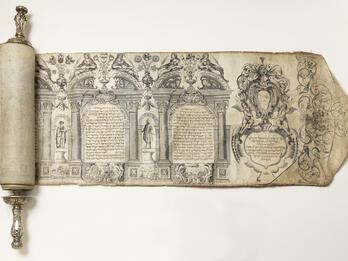Responsum: On Printed Megilot (Scrolls of) Esther
Moses Provenzali
1560
Question: . . . When Rabbi Joseph Ottolenghi was visiting this land, he told me that he printed sixteen megillot on parchment prepared for this purpose [i.e., to be used for the scrolls—Ed.]. When I expressed my surprise, he told me that he does not allow anyone to fulfill his obligation by reading from them, although he would find it very…
Creator Bio
Moses Provenzali
Moses Provenzali was one of the greatest Italian talmudic scholars of his time and was at the heart of several controversies. He was severely criticized for his position on the divorce of Samuel Venturozzo (1564)—an issue that divided Italian rabbis—for ruling that the divorce was invalid because it was made under duress. Indeed, the rabbis of Venice forbade him to hold office for three years (although it seems the ruling was not implemented), and many called for his excommunication. However, Provenzali received the support of rabbis of Safed, including Joseph Karo, and continued to serve as chief rabbi of Mantua until his death. Provenzali wrote an approbation for the first edition of the Zohar (Mantua, 1558). He wrote a guide to Hebrew grammar in verse and a geometric treatise, in addition to many responsa, and commentaries on talmudic tractates and on Maimonides’ Guide of the Perplexed. Many of his writings remain in manuscript.
Related Guide
Jewish Printing and Book Culture
Jewish printing unified far-flung communities by standardizing religious texts, created textual uniformity, and enabled vernacular translations, and facilitated the spread of Jewish texts and knowledge.
Related Guide
Early Modern Italy: Where East and West Meet
Ashkenazim, Sephardim, and Marranos encountered each other in Italian cities, developing community structures that later influenced Jewish communal organization throughout the western world.
Related Guide
Early Modern Jewish Languages
As Ashkenazi and Sephardi Jews migrated eastward, Yiddish and Ladino emerged as distinct languages. Both languages developed literary traditions, as print became more widespread.
You may also like
Colophon: Tikune ha-Zohar (Mantua Edition)



